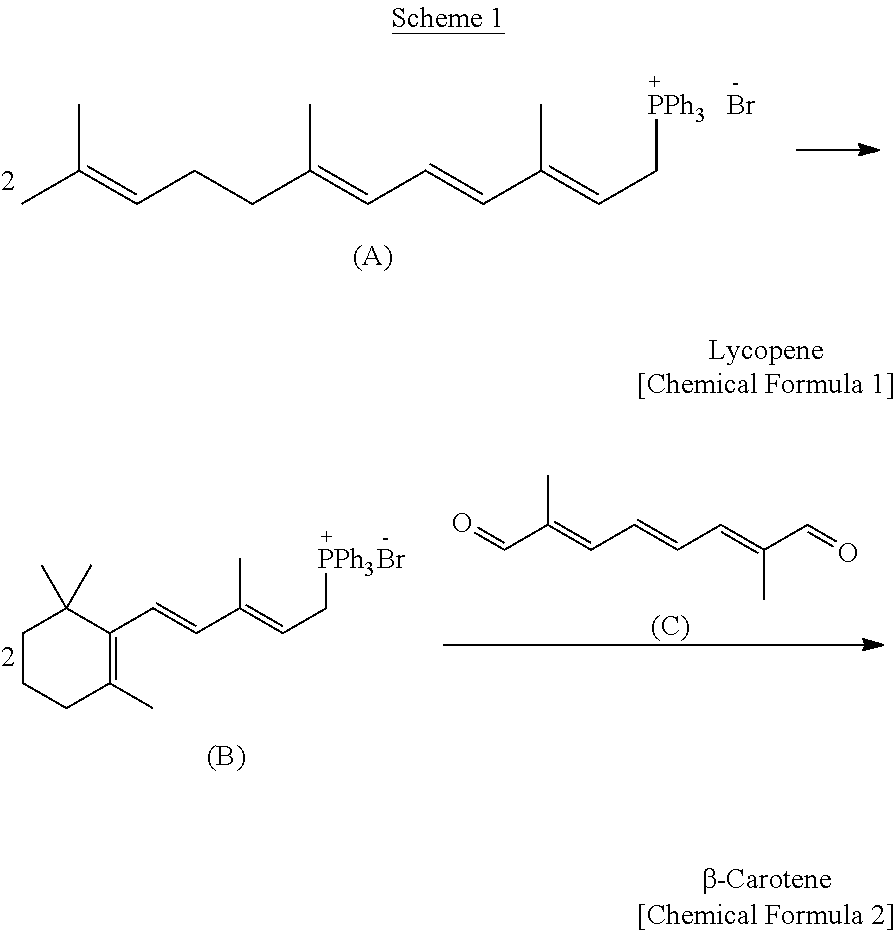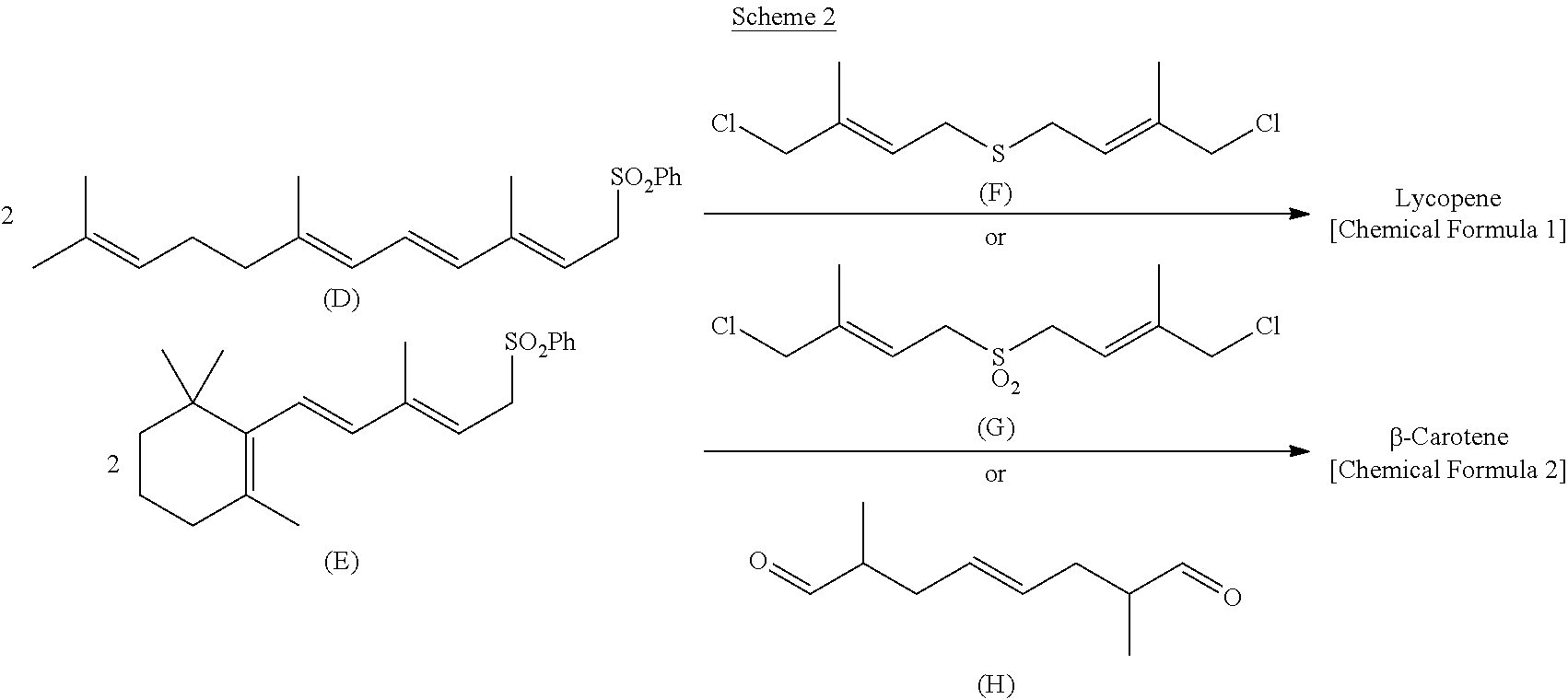Dialdehyde compound, preparation method thereof, and synthetic method of carotenoids using the same
a technology of dialdehyde and compound, which is applied in the field of new c20 dialdehyde, synthetic method thereof, and synthetic method of carotenoid compounds, and achieves the effect of high efficiency, efficient and expedient synthesizing of carotenoid compounds
- Summary
- Abstract
- Description
- Claims
- Application Information
AI Technical Summary
Benefits of technology
Problems solved by technology
Method used
Image
Examples
example 1
8-Benzenesulfonyl-2,6,11,15-tetramethyl-2,6,10,14-hexadecatetraenedial (J)
[0039]To a stirred solution of geranyl sulfone (I) (5.00 g 17.93 mmol) in DMF (50 mL) at −20° C. was added t-BuOK (2.33 g, 19.72 mmol). The resulting orange mixture was stirred at that temperature for 30 min, and a solution of geranyl bromide (4.28 g, 19.72 mmol) in DMF (10 mL) was added. The mixture was stirred at −20° C. for 1 h, and quenched with 1 M HCl solution (20 mL). The mixture was extracted with EtOAc (50 mL), washed with 1 M HCl (10 mL×3), dried over anhydrous Na2SO4, filtered, and concentrated under reduced pressure. The crude product was purified by silica gel column chromatography to give the coupling product (J) (7.10 g, 17.12 mmol) in 95% yield.
[0040]1H NMR (300.40 MHz, CDCl.sub.3) δ 1.19 (d, J=1.3 Hz, 3H), 1.57 (s, 3H), 1.59 (s, 3H), 1.60 (s, 3H), 1.65 (s, 3H), 1.68 (s, 3H), 1.90-2.07 (m, 8H), 2.35 (ddd, J=14.0, 10.9, 7.4 Hz, 1H), 2.89 (ddd, J=14.0, 7.2, 3.3 Hz, 1H), 3.73 (ddd, J=10.9, 10.5, 3...
example 2
8-Benzenesulfonyl-2,6,11,15-tetramethyl-2,6,10,14-hexadecatetraene-1,16-diol (K)
[0044]To a stirred suspension of SeO2 (0.54 g, 4.82 mmol, 2 equiv) and salicylic acid (0.34 g, 2.41 mmol, 1 equiv) in CH2Cl2 (20 mL) at 0° C. was added a 3.0 M solution of t-butyl hydrogen peroxide (TBHP) in toluene (5.0 mL, 14.46 mmol, 6 equiv). The mixture was stirred at that temperature for 1.5 h, and a solution of the compound (J) (1.00 g, 2.41 mmol, 1 equiv) in CH.sub.2Cl.sub.2 (5 mL) was slowly added for 10 min. The reaction mixture was stirred at 0° C. for 3 h, diluted with CH2Cl2 (30 mL), washed with 10% NaOH solution (10 mL×3) and then saturated Na2S2O3 solution (10 mL×3), dried over anhydrous Na2SO4, filtered, and concentrated under reduced pressure. The crude product was purified by silica gel column chromatography to give the diol compound (K) (0.47 g, 1.06 mmol) in 44% yield, together with the hydroxyl-aldehyde (0.13 g, 0.29 mmol, 12% yield), which was derived from further oxidation. Both of...
example 3
8-Benzenesulfonyl-2,6,11,15-tetramethyl-2,6,10,14-hexadecatetraenedial (Chemical Formula 3)
[0049]Method A: Oxidation from the Compound (K)
[0050]To a stirred solution of the diol compound (K) (0.30 g, 0.68 mmol) in CH2Cl2 (20 mL) was added MnO2 (1.77 g, 20.4 mmol). The mixture was stirred at room temperature for 48 h, and filtered. The filter cake was rinsed with CH2Cl2, and the combined organic layer was concentrated under reduced pressure. The crude product was purified by silica gel column chromatography to give the dialdehyde of the Chemical Formula 3 (0.18 g, 0.41 mmol) in 60% yield.
[0051]Method B: Oxidation from the Compound (J) Through the Compound (K)
[0052]To a stirred suspension of SeO2 (0.54 g, 4.82 mmol, 2 equiv) and salicylic acid (0.34 g, 2.41 mmol, 1 equiv) in MeCN (15 mL) at 0° C. was added a 3.0 M solution of TBHP in toluene (5.0 mL, 14.46 mmol, 6 equiv). The mixture was stirred at that temperature for 1.5 h, and a solution of the compound (J) (1.00 g, 2.41 mmol, 1 eq...
PUM
 Login to View More
Login to View More Abstract
Description
Claims
Application Information
 Login to View More
Login to View More - R&D
- Intellectual Property
- Life Sciences
- Materials
- Tech Scout
- Unparalleled Data Quality
- Higher Quality Content
- 60% Fewer Hallucinations
Browse by: Latest US Patents, China's latest patents, Technical Efficacy Thesaurus, Application Domain, Technology Topic, Popular Technical Reports.
© 2025 PatSnap. All rights reserved.Legal|Privacy policy|Modern Slavery Act Transparency Statement|Sitemap|About US| Contact US: help@patsnap.com



